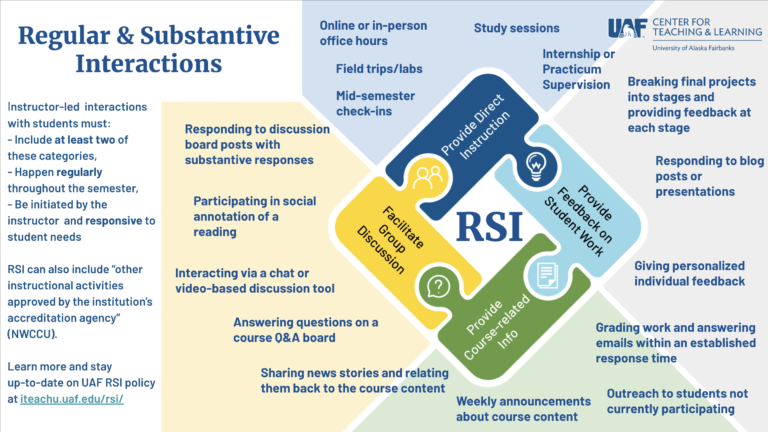
Some perspective on the new UAF RSI checklist
Do you sometimes find yourself feeling like Bilbo Baggins, “like butter scraped over too much bread,” when it comes to communicating with all your students? The new federal regulations around instructor-student interactions in distance education may seem like an additional burden – a new acronym to worry about even though you are already working hard to manage the students in the classes you teach. My goal in this article is to take that vague anxiety and turn it into a sense of confidence that you can meet and exceed these new requirements without spreading yourself even thinner.
Take a look at the new RSI Interactive Worksheet published by the UAF Center for Teaching and Learning, and I’ll walk you through it.
Technically, It’s a Pretty Low Bar
First of all, Regular and Substantive Interaction (RSI) guidelines were set by the federal government because they are worried about subsidizing low-interaction “correspondence courses” with student grants and loans. If you’ve ever taken a paper correspondence course, you know how on-your-own you are as a student. An online course needs human contact from a qualified instructor to be eligible for the same federal benefits as in-person classes. On the interactive worksheet, you’ll see that things like “giving feedback” “answering emails promptly,” and “holding office hours” are examples of RSI. Also, as a means of recognizing the range of distance education, you are only required to demonstrate fulfillment of two categories, one of which can be “Other Activities.”
However, the Spirit of RSI is about Student Success
The new focus on RSI can instead be an opportunity to reflect on the value you bring to a course as its instructor. Your course policies, organization, and responsiveness fosters trust and helps students establish a connection with you. Your expertise and attitude adds to the insightfulness of your feedback, your curation of course materials, and the way you guide discussions and answer questions.
Students’ perceived connection with an instructor, and the passion that instructor displays for the subject matter are two of the biggest predictors that students will consider the course to be memorable, or even transformative [1]. The teaching chops of UAF faculty are a primary reason why students choose this institution and persist to complete their degrees – and that’s what administrators and accreditors are looking for.
RSI Smarter, Not Harder
Take a moment to think about how you interact with students in your course. Here are some questions that can help identify ways you can change your practices to make them more impactful.

Certain teaching tasks take up an outsized amount of time and effort
Professor A spends a lot of time grading homework, and it piles up especially around the two midterms and the final exam. This leads to short feedback comments, and sometimes Professor A returns homework after the midterm that covers it.
Change: Professor A now releases the homework answers after the due date. Students self-correct their homework, and submit their corrections for the complete grade, which is now complete/incomplete. Professor A monitors homework submissions and directly reaches out to students who need help. There are now practice tests before each exam – also graded complete/incomplete – Professor A focuses on giving detailed feedback on these and returns them before the exams.
Students who need help the most don’t seem to ask for it
Instructor B lists office hours “by appointment only” on his syllabus. Only a handful of the highest-achieving students schedule appointments every semester.
Change: Since his classes are fairly small, Instructor B instituted check-ins with every student during the first third of the semester. They are required to set up a 20-minute meeting in-person or via Zoom using an appointment calendar. Instructor B uses it as a chance to meet students and talk about their goals for the large final project. He finds that students reach out more after that initial meeting too!
Can your advice to one student be shared with the whole class?
Instructor C teaches several large courses and is always drowning in emails from students with questions about assignments, materials, grades, homework problems, group work, and more.
Change: Instructor C has a “Question Box” form prominently on her course homepage. It is anonymous and has instructions about what kinds of questions should be submitted there. She redirects students who email with general questions to put them in the Question Box instead. The questions are addressed in announcements that go out 1-2 times a week. These announcements also contain an overview of the week and commentary from Instructor C. Students are able to comment on the announcements if they have follow-up questions. By mid-semester, students are trained to only email Instructor C with personal questions not suitable for the Question Box.
Instructor C also spends some time working with an instructional designer to improve the navigation and assignment instructions in her course.
A drop-off in engagement usually occurs mid semester
The weekly discussion board posts start feeling stale to both Professor D and their students about mid-way through the semester.
Change: Professor D turned discussions into a peer-learning activity where small groups of students take turns preparing discussion materials and questions and facilitating the discussion. Student groups share their work with Professor D a week in advance so they can make changes based on feedback.
This method has a bonus of keeping Professor D engaged in discussion too! Students bring in new materials and perspectives, and keep semesters from feeling the same.
References
[1] Pugh, K. J., Bergstrom, C. M., Phillips, M. M., Sexton, J. M., Olson, C., & Riggs, E. M. (2023). Perceived Connection to Instructor and Instructor Passion as Predictors of Transformative Experiences in Science. Education Sciences, 13(5), 526.



